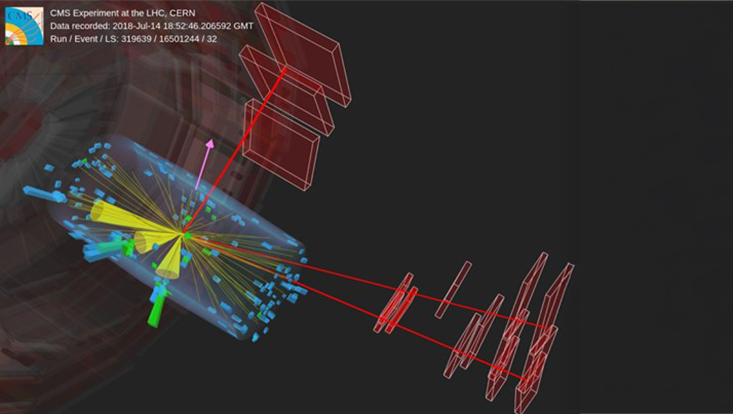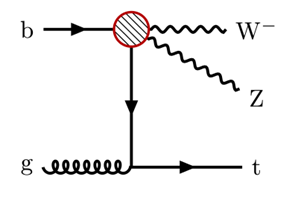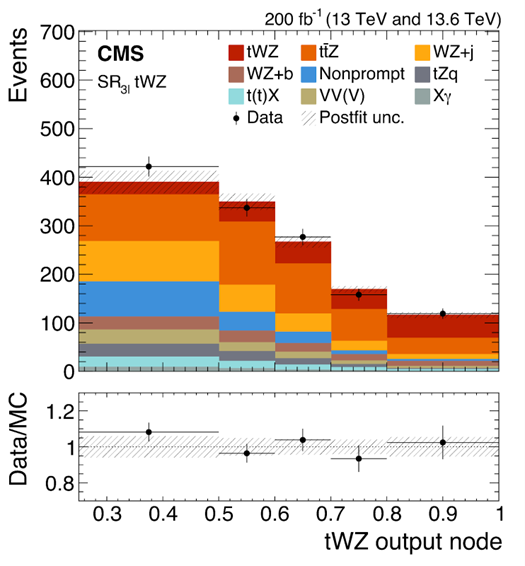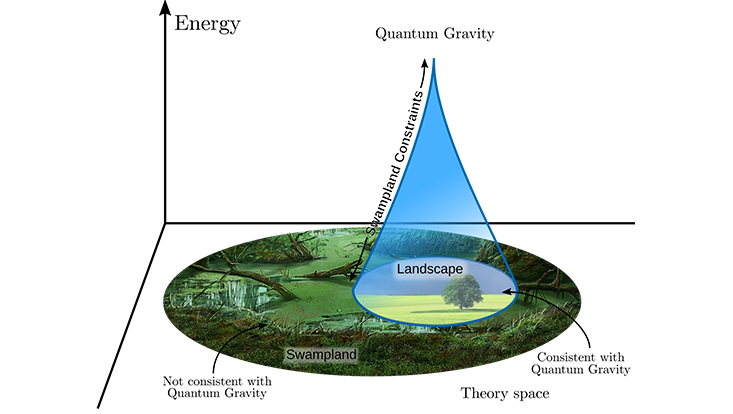Top quark production with W and Z bosonCMS experiment observes rare top quark interaction
24 October 2025

Photo: CMS Collaboration
The CMS experiment reports the first observation of a top quark produced together with a W and a Z boson. A team led by Quantum Universe key researcher Roman Kogler (DESY) has observed a process so rare it occurs only once in a trillion proton-proton collisions. This result presents a new avenue to study the Higgs field and its interaction with the top quark. It is another reminder of the Large Hadron Collider’s ability to uncover nature’s most elusive secrets.
The top quark is the most massive known elementary particle, having a mass larger than 170 times the proton mass. It is the magic of the Brout-Englert-Higgs (BEH) mechanism (Nobel Prize in 2013) that gives it its mass, where the Higgs field couples stronger to the top quark than to any other particle we know of. The W and Z bosons, on the other hand, mediate the electroweak (EW) interaction, which is the unified theory of the electromagnetic and the weak forces. They obtain their large masses by sharing a part of their field with the Higgs field. Physicists predicted that within the standard model it is possible to produce a single top quark together with a W and a Z boson at the LHC, a process that is very rare and elusive. If it exists, this process, called tWZ production, can be used to study the EW interaction of the top quark and reveal the role of the Higgs field in it. Scientists from the CMS Collaboration have now observed tWZ production and have opened a new window into the study of the fundamental forces of nature.

Figure 1: Schematic drawing of tWZ production. The W boson converts the incoming bottom quark into a top quark, which interacts with the Z boson. The red bubble represents the corresponding interaction, possibly with an unknown contribution. credit: CMS Collaboration
Figure 1 shows a schematic drawing (Feynman diagram) of how tWZ production can occur. A measurement of tWZ production represents a significant challenge from both theoretical and experimental perspectives. Because it features similar final states as another rare process, the simultaneous production of a top quark-antiquark pair with a Z boson (ttZ production), careful treatment is required to distinguish these processes.
The tWZ process is one of the rarest standard model processes that can be observed with the current LHC data. Its rate of production is about seven times smaller than even that of ttZ, making it very hard to isolate and identify. “Because of its rarity, observing tWZ production requires advanced analysis techniques involving state-of-the art machine learning”, says Alberto Belvedere, a PhD student at DESY, who is one of the main analyzers on this analysis. He focused on events where three or four electrons or muons were produced, a hallmark signature of tWZ production. To separate signal from the overwhelming background contribution, he uses a transformer-based machine learning algorithm, similar to that used for large-language models like ChatGPT. The result, shown in figure 2, demonstrates this separation.

Figure 2: Distribution in the output score of the machine-learning algorithm, used to isolate the tWZ signal. The signal in dark red cumulates to the right, while background processes contribute more to the left. credit: CMS Collaboration
Using a data set collected from 2016 to 2023, corresponding to 200 inverse femtobarns of collision data, the CMS Collaboration has now identified this process with a statistical significance of 5.8 standard deviations, exceeding five standard deviations, that are the gold standard for a scientific discovery. The measured rate of tWZ production is slightly above the prediction, about 2.3 standard deviations higher. The difference is not yet conclusive evidence of new physics. Future data will reduce the uncertainty and clarify whether this is just a statistical fluctuation or the first hint of something beyond the known laws of physics. “If there are unknown interactions or particles involved, the observed deviation between the measured rate and the prediction would become rapidly larger with increasing energies of the outgoing particles, an effect that is unique to the tWZ process”, says Roman Kogler from DESY and key researcher at the Cluster of Excellence Quantum Universe. “This result is a milestone for the scientific goals of our Cluster”, says Prof. Erika Garutti, spokesperson of the Cluster of Excellence Quantum Universe, “as it provides a new way of studying the interaction of the top quark with the electroweak force and the Higgs field.“
(written by Roman Kogler, adapted from CMS physics briefing: CMS observes rare top quark interaction with a W and a Z boson)


